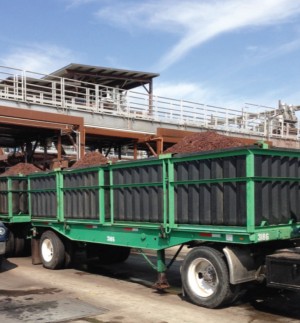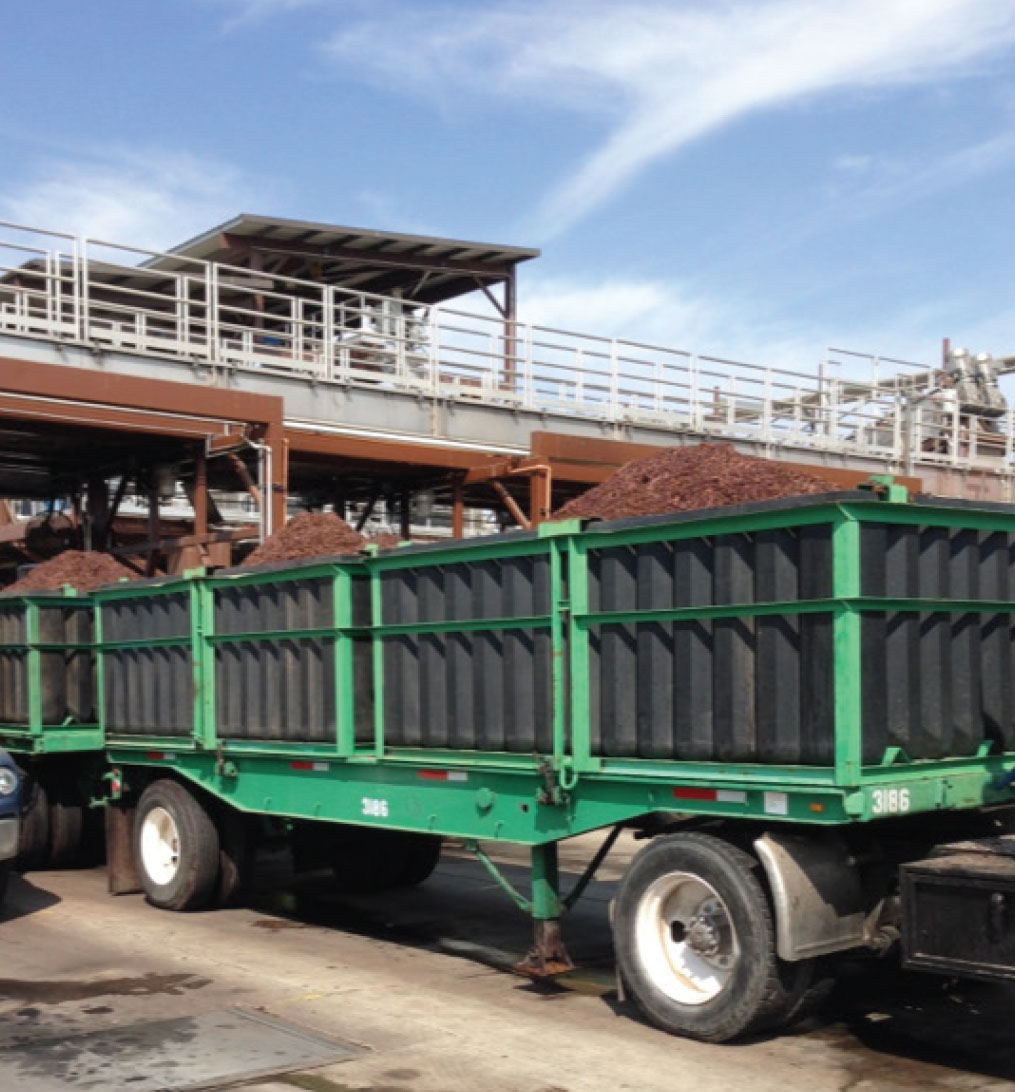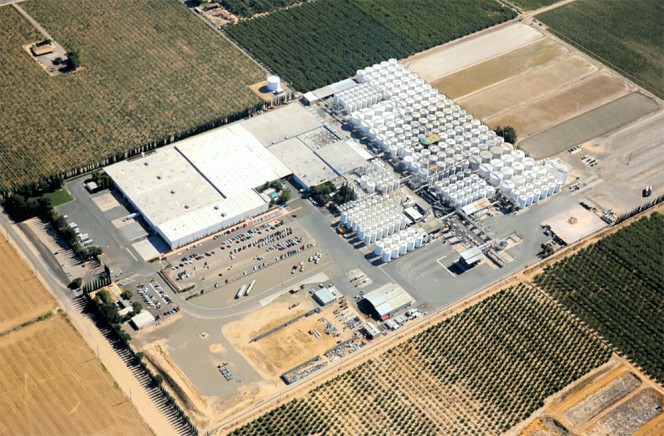The U.S. Zero Waste Business Council’s certification requires facilities to have a minimum of 90 percent overall diversion from landfills, incineration and the environment.
Claire Siegrist
BioCycle February 2016

Bronco Wine Company’s facility in Ceres, California sends its pomace — grape skin, stems and seeds — to another winery to extract the grape seed oil, after which it is used to feed cattle.
The U.S. Zero Waste Business Council (USZWBC) created the first third-party Zero Waste Facility Certification program in 2013, which meets the Zero Waste (ZW) definition of the Zero Waste International Alliance (ZIWA). This program requires facilities to have a minimum of 90 percent overall diversion from landfills, incineration (waste-to-energy), and the environment. “The Facility Certification program not only analyzes diversion but provides additional points in the Facility Certification Scorecard for programs that document materials being reduced, reused, recycled or composted,” explains Stephanie Barger, USZWBC Founder and Executive Director. “Leadership, employee training and Zero Waste purchasing are also critical areas for achieving certification.” Three recently certified facilities are highlighted in this article.
Walt Disney Agricultural Science Facility
The Agricultural Science Facility at The Land Pavilion in Epcot, Walt Disney World Resort in Orlando, Florida, was awarded the USZWBC Platinum Zero Waste Facility Certification in July 2015. It received a 76 out of 81 on the Zero Waste Facility Scorecard, the highest rating of any USZWBC-certified organization to date. This facility of greenhouses, offices and labs has diverted over 98 percent of its waste by implementing an advanced source separation system, waste prevention and engaging employees and interns.
The Agricultural Science Facility covers two acres, including the guest area and backstage, and showcases over 150 different food crops from all over the world. The greenhouses contain thousands of tropical and temperate plants, herbs and edible flowers, and showcase commercial greenhouse agriculture. In 2015, 20 tons of edible produce were distributed to restaurants throughout the park. Lettuce and other produce from the greenhouses are also fed to animals at Disney World’s Animal Kingdom. Surplus plants and residual plant matter are composted on site at a facility near the Magic Kingdom that is managed by Reedy Creek Energy Services (RCES). A small amount of food waste is also collected and sent to Reedy Creek’s anaerobic digester (see “Codigestion In Central Florida,” March/April). In 2015, about 27.5 tons of material were composted.
Les Frey, horticulturist at The Land Pavilion who manages several greenhouses, research labs and the intern program, has been working towards achieving zero waste for eight years. In 2007, composting excess plant material at the Reedy Creek composting facility began. Year after year, the diversion rate increased due to small initiatives like printing double sided and switching to reusable flatware and dinnerware. In 2015, close to 200 tons of recyclables, including aluminum, cardboards and wood pallets, were diverted from landfill and incineration.
According to Frey, since the Agricultural Science Facility’s recent certification, multiple departments around the resort are working towards creating and achieving ZW goals as well. The Walt Disney World Company has a corporate goal throughout the resort of reducing waste going to landfill by 60 percent for operational waste and 75 percent for construction and demolition waste by 2020.
American Licorice
In June 2015, the American Licorice Company (ALC), a privately owned candy manufacturer, received USZWBC’s Gold Zero Waste Facility Certification for its production plant in La Porte, Indiana. To achieve certification before 2016, ALC began in 2012 to replace ingredients and packaging and reduce costs, improve equipment control, and refine its selection of materials and vendors. ALC’s other manufacturing facility in Union City, California was already Gold-Certified and has a 95 percent diversion rate.
The La Porte plant diverts 91 percent from landfill and incineration through recycling and reuse programs. The 300,000 square-foot facility houses one corporate cafeteria that serves 230 employees. A local pig farmer collects about 575 tons/year of food scraps from the manufacturing plant. In addition, 966 tons of recyclables were collected in 2015.
According to Giri Veeramuthu, Director of Quality at ALC, the Indiana facility attributes tits zero waste success to two key changes: 1) Increasing knowledge about what can be recycled; and 2) More efficiently tracking metrics. Department managers are responsible for waste management and educating coworkers. Emphasizing recycling and tracking of key materials, such as shipping pallets, steel drums, electronics and scrap metal, was essential in reaching the diversion goal.
A camera system was installed to pinpoint individuals who made errors in waste disposal. When an error was spotted, Cliff Walsh, Vice-President of Operations, would educate the individual and department where the incident occurred. Departments also got rid of desk-side bins; employees must dispose their waste in a central location, where descriptive signs educate them about proper disposal. ALC’s other initiatives include bulk purchasing to reduce packaging material, using local suppliers to reduce transportation costs, and preference towards EPA Smart Way transportation carriers.
“Upper management is very interested in this initiative and making the company as sustainable as possible, through zero waste and carbon neutrality goals,” notes Veeramuthu. ALC’s goal is to attain the Platinum Zero Waste Certification.
Bronco Wine Company
The Bronco Wine Company in California is the fifth largest winery and the largest vineyard owner in the United States. In September 2015, the company’s facility in Ceres, California received USZWBC’s Gold Facility Certification. It has diverted 99.7 percent of its waste and reduced landfill use by 50 percent since 2004. In 2014, over 56,700 tons were diverted from landfill and incineration. This included 350 tons of metal, 58 tons of plastic, 130 tons of fiber, 27 tons of wood and 51,460 tons of pomace (grape skin, stems and seeds). The pomace is sent to another winery to extract the grape seed oil, after which it is used to feed cattle.
Bronco focuses on reuse to reduce its waste. A fertilizer company picks up diatomaceous earth, which is used to filter finished wine, and spreads it on nearby orchards as a soil amendment. In 2014, 4,205 tons were collected and reused. Additionally, grape vines are clipped after harvest and tilled back into the soil. Color-coded recycling bins are placed around the Ceres facility for 300 employees to deposit their recyclables. According to Robert Hall, Production Manager, the Ceres facility’s goal is to reach the platinum level of certification and for Bronco’s facilities in Napa, Sonoma, Madera and Escalon to achieve a diversion rate over 90 percent in order to be eligible to apply for the USZWBC Certification.
Claire Siegrist is a Contributing Editor to BioCycle.














